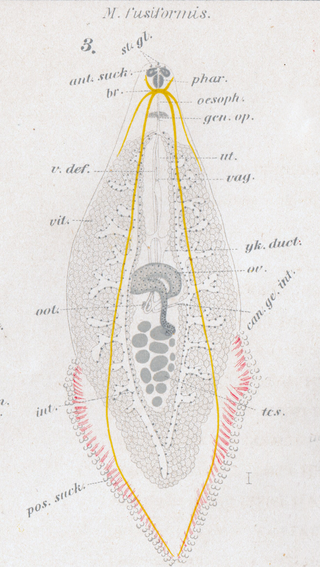
Microcotyle angelichthys is a species of monogenean, parasitic on the gills of a marine fish. It belongs to the family Microcotylidae.
Microcotyle argenticus is a species of monogenean, parasitic on the gills of a marine fish. It belongs to the family Microcotylidae. It was described from the gills of the silver pomfret Pampus argenteus (Stromateidae) from Karachi coast off Pakistan.
Microcotyle arripis is a species of monogenean, parasitic on the gills of a marine fish. It belongs to the family Microcotylidae.
Microcotyle bothi is a species of monogenean, parasitic on the gills of a marine fish collected in Hawaii. It belongs to the family Microcotylidae.
Microcotyle caudata is a species of monogenean, parasitic on the gills of a marine fish. It belongs to the family Microcotylidae.
Microcotyle constricta is a species of monogenean, parasitic on the gills of a marine fish. It belongs to the family Microcotylidae.
Microcotyle longirostri is a species of monogenean, parasitic on the gills of a marine fish. It belongs to the family Microcotylidae.
Microcotyle odacis is a species of monogenean, parasitic on the gills of a marine fish. It belongs to the family Microcotylidae.

Microcotyle fusiformis is a species of monogenean, parasitic on the gills of a marine fish, described by Seitarō Gotō in 1894. It belongs to the family Microcotylidae. This species was first.
Microcotyle emmelichthyops is a species of monogenean, parasitic on the gills of a marine fish in Hawaii. It belongs to the family Microcotylidae.
Microcotyle eueides is a species of monogenean, parasitic on the gills of a marine fish. It belongs to the family Microcotylidae.
Microcotyle gimpo is a species of monogenean, parasitic on the gills of a marine fish. It belongs to the family Microcotylidae.
Microcotyle stenotomi is a species of monogenean, parasitic on the gills of a marine fish. It belongs to the family Microcotylidae and was first described by Goto in 1899.

Microcotyle sebastis is a species of monogenean, parasitic on the gills of a marine fish. It belongs to the family Microcotylidae.
Microcotyle hiatulae is a species of monogenean, parasitic on the gills of a marine fish. It belongs to the family Microcotylidae. This species was first described by Goto in 1899.
Microcotyle jonii is a species of monogenean, parasitic on the gills of a marine fish. It belongs to the family Microcotylidae. It was described from the gills of Lutjanus jonii (Lutjanidae) from Karachi coast off Pakistan.
Microcotyle rubrum is a species of monogenean, parasitic on the gills of a marine fish. It belongs to the family Microcotylidae. It was described from the gills of the tigertooth croaker Otolithes ruber (Sciaenidae) from Karachi coast off Pakistan.
Microcotyle zalembius is a species of monogenean, parasitic on the gills of a marine fish. It belongs to the family Microcotylidae. It was first described an illustrated based on 43 specimens from the gills of the pink seaperch Zalembius rosaceus (Embiotocidae) off San Pedro, California.
Microcotyle pontica is a species of monogenean, parasitic on the gills of a marine fish. It belongs to the family Microcotylidae. It was first described and illustrated from the gills of the east Atlantic peacock wrasse Symphodus tinca (Labridae), from the Black Sea.
Microcotyle isyebi is a species of monogenean, parasitic on the gills of a marine fish. It belongs to the family Microcotylidae.




